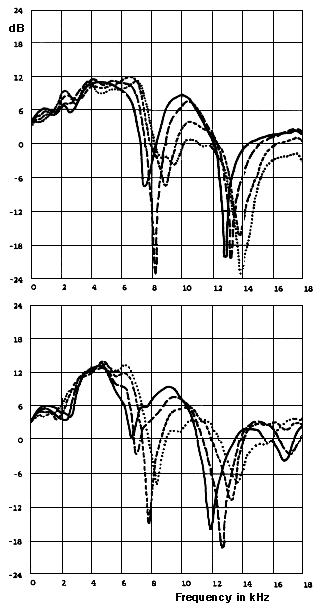
 |
Pinna |
(Latin: pinna = wing; plural: pinnae) The ear flaps or outer part of the ear called the auricle.
Recent research indicates that the pinnae are of importance in sound localization since they reflect incoming sound in ways that depend on the angle of the source. Front-back distinctions appear to be made on the basis of the reflections off the various ridges of the pinnae. Since these reflections do not occur for sounds coming from behind, sounds lacking this information (as in most microphone recordings) tend to be localized toward the back of the listener when heard over headphones. Pinna reflections also affect the perception of height. See diagrams under binaural hearing, and the head-related transfer function (HRTF) that describes pinna colouration (below).
Pinna reflections colour the sound in the manner of a comb filter, but with the cancelled frequencies being in the 6-8 kHz range and above 12 kHz.

Head-related transfer functions (HRTF) for two subjects illustrating spectral colouration for increasing source elevation in the lateral plane. The sound was located 2 meters to the left of the subject and was moved from ear level (0 degrees) to an elevation 30 degrees above ear level (solid line: 0 degrees; long dashes: 10 degrees; short dashes: 20 degrees; dotted line: 30 degrees). From G. Kendall & W. Martens, "Simulating the cues of spatial hearing in natural environments," Proceedings of the 1984 International Computer Music Conference, used by permission of the authors.
Compare: Phasing, Presbycusis, Sound Shadow. See also: Acoustic Impedance, Binaural Recording, Kunstkopf, Stereophonic.